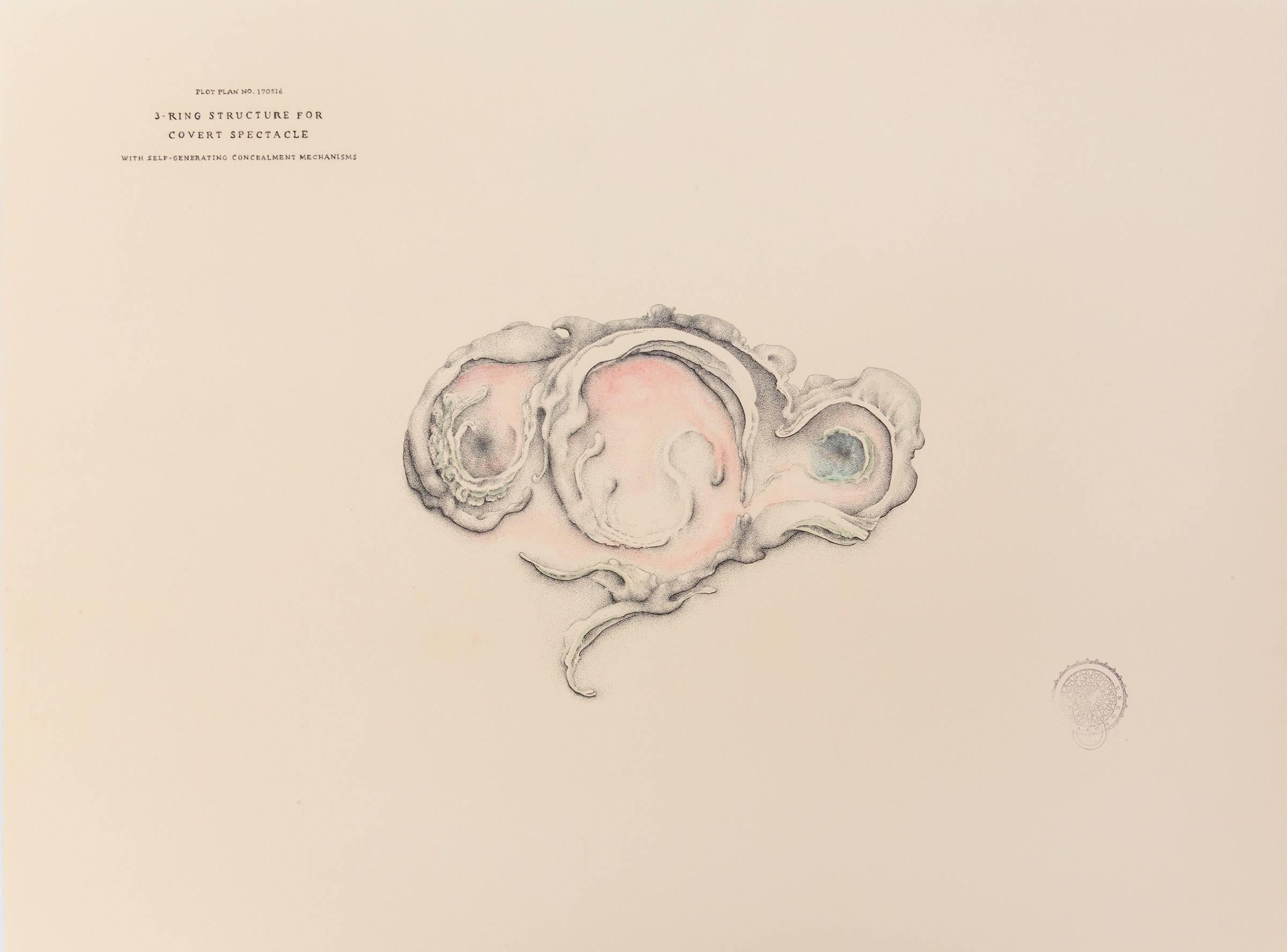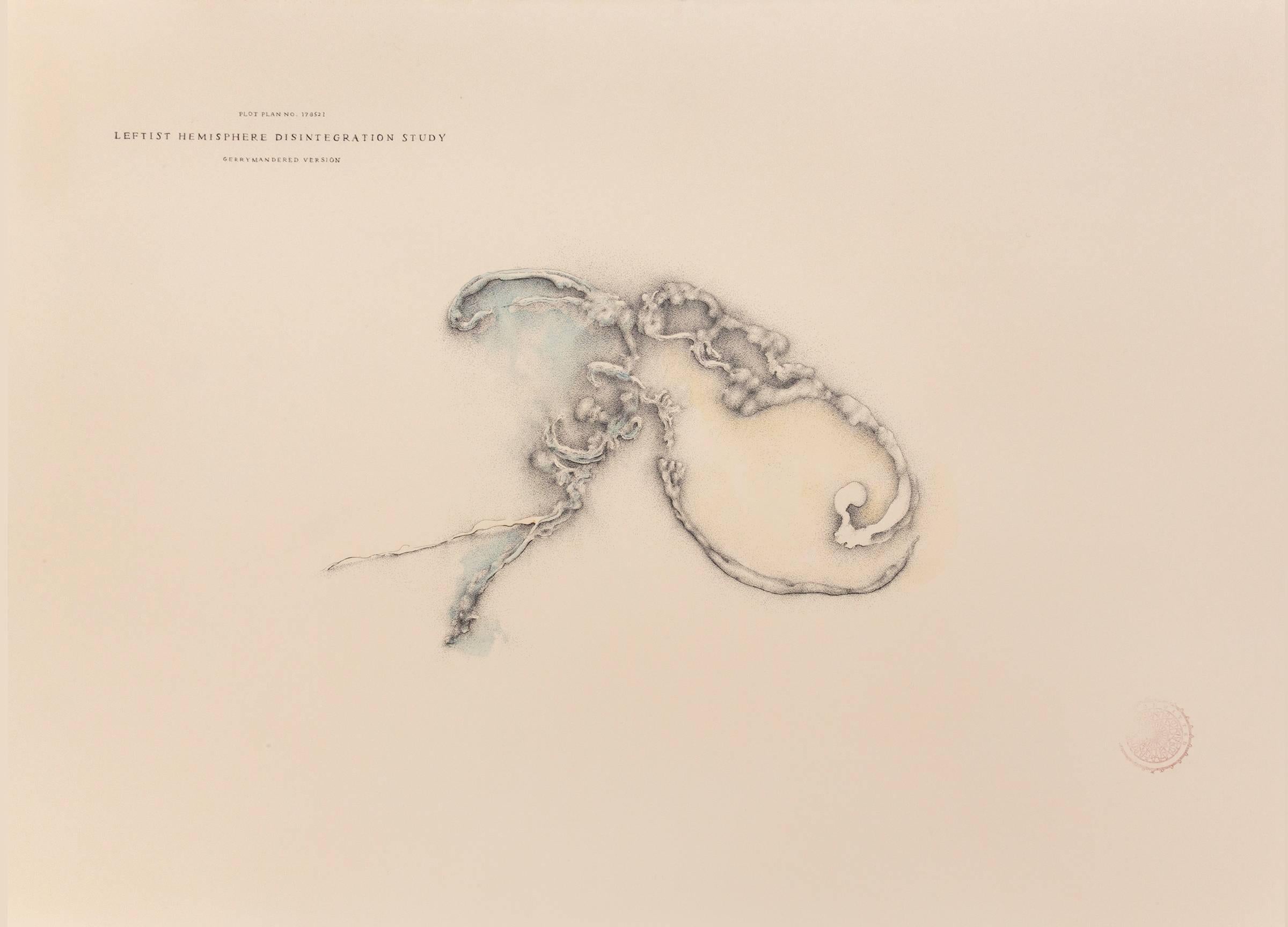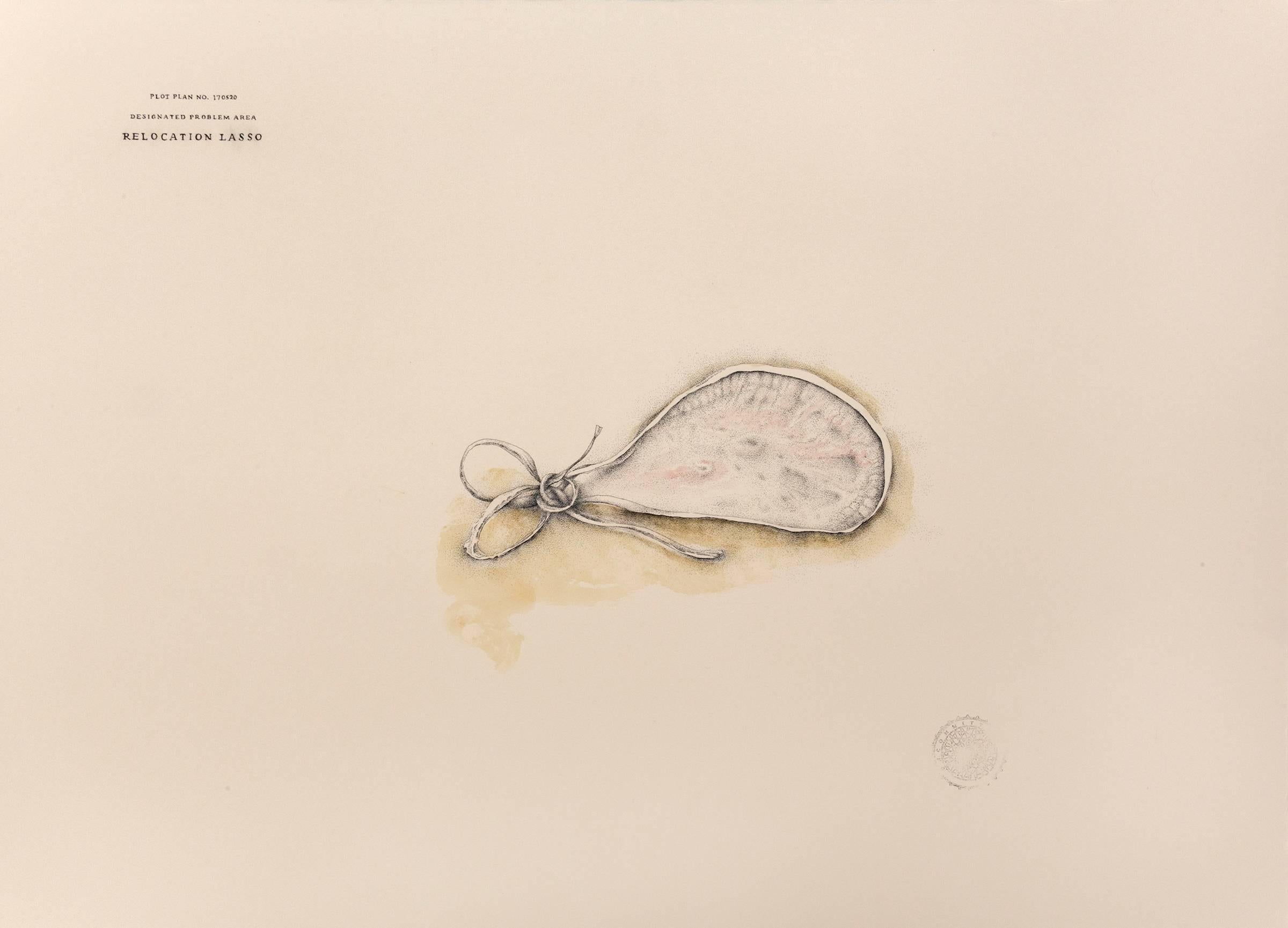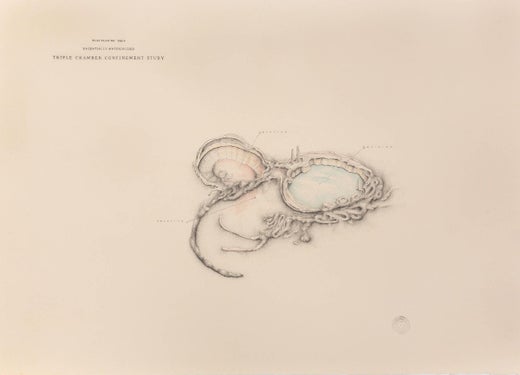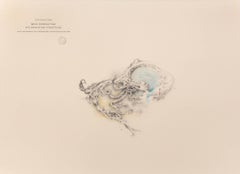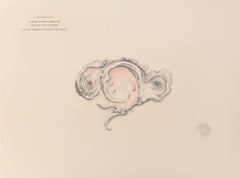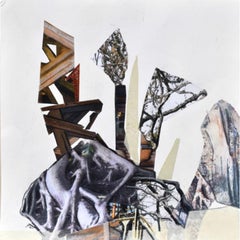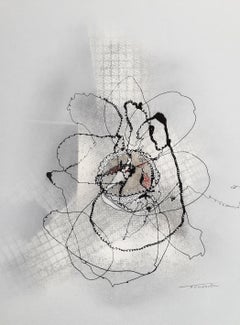Items Similar to Plot Plan No. 170519
Want more images or videos?
Request additional images or videos from the seller
1 of 8
Patricia SmithPlot Plan No. 1705192016
2016
$3,160
£2,407.44
€2,775.87
CA$4,422.36
A$4,941.25
CHF 2,584.82
MX$60,595.52
NOK 33,029.09
SEK 31,320.32
DKK 20,717.82
Shipping
Retrieving quote...The 1stDibs Promise:
Authenticity Guarantee,
Money-Back Guarantee,
24-Hour Cancellation
About the Item
Plot Plan No. 170519 Full-Dress Protectionist Pad With Knotted Entrance Strategy
This ink and watercolor, work on paper is from Patricia Smith's newly released series: "Shelter in Place" in which Smith envisions structures, shelters and cityscapes that are designed to contain conflicting desires, thoughts and impulses. Her titles and text captions point to a process of capturing ideas floating in the mental field and translating them into concrete objects. In considering the spatial foundation and corporeal properties of language itself, the works allude to various lines of philosophical and linguistic theory, such as Walter Benjamin’s evocation of space in his literary experiments with the “Denkbild”, or figure of thought.
Smith’s structures effectively function as containers for “housing” phrases and ideas that have become trapped in consciousness through saturating news reports, overheard conversations or emotional touch points. By giving repetitive or troubling thoughts their own buildings, she suggests that one might arrange, contemplate and recontextualize them until they become understandable.
Patricia Smith has exhibited widely in the US and internationally, including a recent solo project at 34 rue Gutenberg in Paris, and exhibitions at l’ESAD in Grenoble, France, Broadcast Gallery in Dublin, BRIC in Brooklyn and Stedelijk Museum in Aalst, Belgium. Her work has been reviewed in numerous publications, including Art in America, The New York Times, the LA Times, Daily Serving and L Magazine. She was awarded artist residencies for 2013 and 2015 at Cité Internationale des Arts in Paris and in 2014 was an artist-in-residence at Kaus Australis in Rotterdam. She was a 2014 New York Foundation of the Arts fellow in Drawing/Printmaking/Artist’s Books. She currently lives and works in Paris.
- Creator:Patricia Smith (1944, American)
- Creation Year:2016
- Dimensions:Height: 22.25 in (56.52 cm)Width: 30 in (76.2 cm)
- Medium:
- Movement & Style:
- Period:
- Condition:
- Gallery Location:New York, NY
- Reference Number:1stDibs: LU6922215693
Patricia Smith
Known for her idiosyncratic cartographic explorations of the psyche and mental states, Smith incorporates outer and inner geographical regions in this piece. The finished work is a delicate, highly detailed painting on paper incorporating images and texts rendered in ink and watercolor. (signed on the reverse) Patricia Smith has exhibited widely in the US and internationally, including recent exhibitions at Broadcast Gallery in Dublin, Ireland, Housatonic Museum in Bridgeport, CT, Voorkamer in Lier, Belgium, Bob Rauschenberg Gallery in Fort Meyers, FL and other venues in Paris, New York, Los Angeles and Montreal. Her work has been reviewed in numerous publications, including The New York Times, Art in America, the LA Times and L Magazine. She was awarded a residency at Cité Internationale des Arts in Paris and was artist in residence at Stichting Kaus Australis in Rotterdam.
About the Seller
5.0
Vetted Professional Seller
Every seller passes strict standards for authenticity and reliability
Established in 1999
1stDibs seller since 2014
80 sales on 1stDibs
Typical response time: 3 hours
- ShippingRetrieving quote...Shipping from: New York, NY
- Return Policy
Authenticity Guarantee
In the unlikely event there’s an issue with an item’s authenticity, contact us within 1 year for a full refund. DetailsMoney-Back Guarantee
If your item is not as described, is damaged in transit, or does not arrive, contact us within 7 days for a full refund. Details24-Hour Cancellation
You have a 24-hour grace period in which to reconsider your purchase, with no questions asked.Vetted Professional Sellers
Our world-class sellers must adhere to strict standards for service and quality, maintaining the integrity of our listings.Price-Match Guarantee
If you find that a seller listed the same item for a lower price elsewhere, we’ll match it.Trusted Global Delivery
Our best-in-class carrier network provides specialized shipping options worldwide, including custom delivery.More From This Seller
View AllPlot Plan No. 170518
By Patricia Smith
Located in New York, NY
Plot Plan No. 170518 Self-Generating Polarization Structure With Pronounced Left Hemisphere Compartmentalization
This ink and watercolor, work on paper is from Patricia Smith's newl...
Category
2010s Conceptual Landscape Drawings and Watercolors
Materials
Archival Ink, Watercolor, Archival Paper
Plot Plan No. 10616
By Patricia Smith
Located in New York, NY
Plot Plan No. 10616 Potentially Materialized Triple Chamber Confinement Study
This ink and watercolor, work on paper is from Patricia Smith's newly released series: "Shelter in...
Category
2010s Conceptual Landscape Drawings and Watercolors
Materials
Archival Ink, Watercolor, Archival Paper
Conceptual Drawing: Plot Plan No. 170516
By Patricia Smith
Located in New York, NY
Plot Plan No. 170516 3-Ring Structure for Covert Spectacle With Self-Generating Concealment Mechanisms
framed, signature on reverse
This ink and watercolor, work on paper is from ...
Category
2010s Conceptual Landscape Drawings and Watercolors
Materials
Ink, Watercolor, Archival Paper
Plot Plan No. 13821
By Patricia Smith
Located in New York, NY
Plot Plan No. 13821 For Proposed Positive Aspect Containment Strategy, watercolor and ink on paper, signed on reverse by the artist and presentd framed in a high quality shadowbox fr...
Category
2010s Conceptual Landscape Drawings and Watercolors
Materials
Archival Ink, Watercolor, Archival Paper
Leftist Hemisphere Disintegration Study Gerrymandered Version
By Patricia Smith
Located in New York, NY
Ink and watercolor on paper, signed on reverse.
Presented floated in a finely crafted hardwood frame.
Titled as: "Plot Plan No. 178521 Leftist Hemisphere Disintegration Study Gerry...
Category
2010s Conceptual Landscape Drawings and Watercolors
Materials
Archival Ink, Watercolor, Archival Paper
Relocation Lasso
By Patricia Smith
Located in New York, NY
Designated Problem Area Relocation Lasso (Plot Plan No. 170520 )
framed, with signature on reverse
This ink and watercolor, work on paper is from Patricia Smith's newly released ser...
Category
2010s Conceptual Landscape Drawings and Watercolors
Materials
Archival Ink, Watercolor, Archival Paper
You May Also Like
Transplant Series III Drawing by Jennifer Gunlock, 2024
Located in Orange, CA
Transplant Series III, 2024
Additional information:
Medium: Mixed media paper collage and drawing on rag paper
Dimensions: 12 x 12 inches
Jennifer Gunlock (American, b. 1972) explo...
Category
21st Century and Contemporary Abstract Paintings
Materials
Mixed Media, Rag Paper
Untitled
Located in Barcelona, BARCELONA
the painting is being offered with a work and authenticity certificate
Category
2010s Abstract Drawings and Watercolors
Materials
Paper, Mixed Media
Transplant Series II Drawing by Jennifer Gunlock, 2024
Located in Orange, CA
Transplant Series II, 2024
Additional information:
Medium: Mixed media paper collage and drawing on rag paper
Dimensions: 12 x 12 inches
Jennifer Gunlock (American, b. 1972) explor...
Category
21st Century and Contemporary Abstract Paintings
Materials
Mixed Media, Rag Paper
Transplant Series V Drawing by Jennifer Gunlock, 2024
Located in Orange, CA
Transplant Series V, 2024
Additional information:
Medium: Mixed media paper collage and drawing on rag paper
Dimensions: 15 x 11 inches
Jennifer Gunlock (American, b. 1972) explore...
Category
21st Century and Contemporary Abstract Paintings
Materials
Mixed Media, Rag Paper
Untitled II
By Anastasia Pelias
Located in New Orleans, LA
ANASTASIA PELIAS was born in New Orleans, LA to Greek parents. Her artistic practice is rooted in the dual cultural identity of both her native and ancestral roots in New Orleans, LA...
Category
21st Century and Contemporary Contemporary Abstract Drawings and Waterco...
Materials
Paper, Charcoal
Transplant Series VIII Drawing by Jennifer Gunlock, 2024
Located in Orange, CA
Transplant Series VIII, 2024
Additional information:
Medium: Mixed media paper collage and drawing on rag paper
Dimensions: 15 x 11 inches
Jennifer Gunlock (American, b. 1972) expl...
Category
21st Century and Contemporary Abstract Paintings
Materials
Mixed Media, Rag Paper
More Ways To Browse
Patricia Field
Antique French Painting
Small Oil Paintings
The Artist Mother
Belgian Artist
The Paris Salons
Time Further
Signed David
La Fine Art
Academy Award
Japanese Paper Art
Antique Print Etching
American Of Chicago
Black And White Photography Series
Salon Painting
German Painter
Purple Paintings
Hand Signed Lithographs


